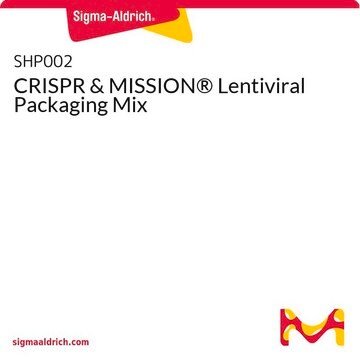CRISPR12V
CRISPR-Lenti Non-Targeting Control Transduction Particles
Sign Into View Organizational & Contract Pricing
All Photos(1)
About This Item
UNSPSC Code:
41106609
NACRES:
NE.02
Recommended Products
form
liquid
packaging
vial of 200 μL
concentration
1x106 VP/ml (via p24 assay)
application(s)
CRISPR
shipped in
dry ice
storage temp.
−70°C
Related Categories
General description
The Sigma lenti CRISPR Non-Targeting Control is a lentiviral system, which includes a gRNA sequence that does not target known human, mouse and rat genes. The non-targeting control lentivirus is useful as a negative control in experiments using Sigma CRISPR lentiviral clones. The Sigma lenti CRISPR non-targeting control uses a one-plasmid system consisting of a EF1-alpha-driven Cas9, a U6-driven guide RNA (non-targeting), with both Puromycin and GFP co-expressed with Cas9.
Ampicillin and puromycin antibiotic resistance genes provide selection in bacterial or mammalian cells, respectively. Also, self-inactivating replication incompetent viral particles can be produced in packaging cells (HEK293T) by co-transfection with compatible packaging plasmids (Product No. SHP001).
Ampicillin and puromycin antibiotic resistance genes provide selection in bacterial or mammalian cells, respectively. Also, self-inactivating replication incompetent viral particles can be produced in packaging cells (HEK293T) by co-transfection with compatible packaging plasmids (Product No. SHP001).
Application
CRISPR-Lenti Non-Targeting Control Transduction Particles has been used in the transduction of human embryonic kidney 293 luciferase expressing cells with lentiviral particles, isolation of single colonies and MOSPD2 (motile sperm domain containing protein 2) silencing.
Functional Genomics/Screening/Target Validation
To see more application data, protocols, vector maps visit sigma.com/crisprs.
- Non-targeting control, CRISPR lentivirus, viral format, for creating gene knockouts/genetic modifications in cell lines.
To see more application data, protocols, vector maps visit sigma.com/crisprs.
Features and Benefits
Serves as a non-targeting or negative experimental control (lentiviral format) for the CRISPR editing workflow using lenti CRISPRs. This allows you to examine the effect of transduction in your system with the Sigma lenti CRISPR/Cas9 virus.
Physical form
200 μl of 106 TU/ml (via p24 titering assay) lentiviral particles are provided as frozen stock.
Legal Information
Storage Class Code
12 - Non Combustible Liquids
WGK
WGK 3
Flash Point(F)
Not applicable
Flash Point(C)
Not applicable
Certificates of Analysis (COA)
Search for Certificates of Analysis (COA) by entering the products Lot/Batch Number. Lot and Batch Numbers can be found on a product’s label following the words ‘Lot’ or ‘Batch’.
Already Own This Product?
Find documentation for the products that you have recently purchased in the Document Library.
Customers Also Viewed
Newly characterized motile sperm domain-containing protein 2 promotes human breast cancer metastasis.
Salem Y, et al.
International Journal of Cancer. Journal International Du Cancer, 1-33 null
Knocking out Ornithine Decarboxylase Antizyme 1 (OAZ1) Improves Recombinant Protein Expression in the HEK293 Cell Line.
Abaandou L and Shiloach J
Medecine Sciences : M/S, 6(2), 48-48 (2018)
Tina Dahlby et al.
International journal of molecular sciences, 21(21) (2020-11-04)
Selective inhibition of histone deacetylase 3 (HDAC3) prevents glucolipotoxicity-induced β-cell dysfunction and apoptosis by alleviation of proapoptotic endoplasmic reticulum (ER) stress-signaling, but the precise molecular mechanisms of alleviation are unexplored. By unbiased microarray analysis of the β-cell gene expression profile
Jennifer Maning et al.
International journal of molecular sciences, 21(8) (2020-04-25)
Aldosterone (Aldo), when overproduced, is a cardiotoxic hormone underlying heart failure and hypertension. Aldo exerts damaging effects via the mineralocorticoid receptor (MR) but also activates the antiapoptotic G protein-coupled estrogen receptor (GPER) in the heart. G protein-coupled receptor (GPCR)-kinase (GRK)-2
Protocols
Learn about CRISPR Cas9, what it is and how it works. CRISPR is a new, affordable genome editing tool enabling access to genome editing for all.
Our team of scientists has experience in all areas of research including Life Science, Material Science, Chemical Synthesis, Chromatography, Analytical and many others.
Contact Technical Service












